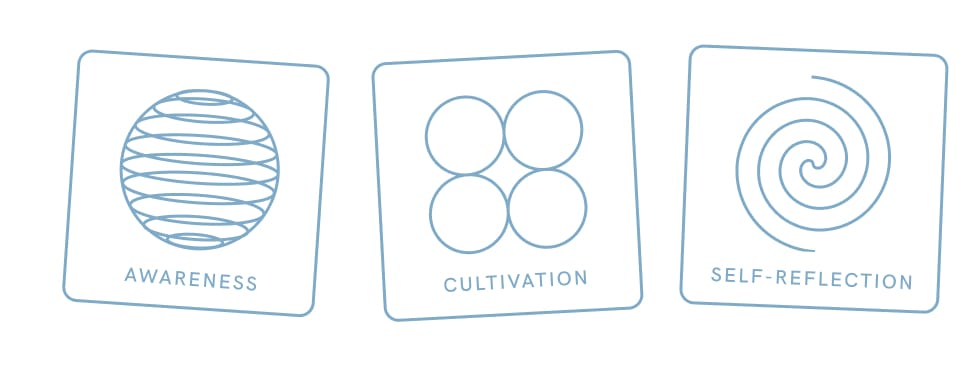- The Mindful CEO
- Posts
- How to Escape Anxiety Overdrive
How to Escape Anxiety Overdrive
The Power of Ritual for Leadership
Today, I will share how I use the power of ritual to get my clients out of their anxiety overdrive.
You will learn how Zen monasteries use ritual to instill a quality of focus.
And in the end, you will even get two manuals that will help you use the power of ritual in your own leadership. Enjoy ☺️
The Power of Ritual for Leadership
Sometimes we are so occupied with what has to happen in the future that we forget to inhabit the now.
As a CEO your job is to predict the future and to navigate towards a favorable outcome for the organization.
This “future focus” comes with downsides:
A leader that only lives in the “future”
goes on anxiety overdrive very fast
misses important intelligence markers in the body or emotions
Is not grounded and cant be “felt” by his team
In other words:
If you dont manage it your “future focus” becomes a liability.
As a result, you can loose grip over your team, miss important information.
Worse you could be so trapped in the “worrying mind overdrive” that you cant see the real possibility in front of you.
How can you learn to escape your anxiety overdrive?
It starts with learning to move from “tomorrow” to the now: The move from thinking obsessively to feeling and observing.
Enter the power of ritual:
A ritual is a symbolic activity or series of actions, performed with intentionality and regularity, that holds cultural, spiritual, psychological, or social significance.
Ultimately, a ritual transforms an ordinary action into an extraordinary moment, imbuing daily life with a sense of purpose, depth, and reflection.
Organizations can use the power of ritual in profound ways.
I once visited Plum Village, an influential modern Zen monastery in France.
While talking with one of the head monks, I heard a loud bell ringing. She stopped talking, closed her eyes, centered herself, and after 20 seconds of mindfulness she continued the conversation.
I was struck.
Plum village’s core value of mindfulness was so important to them that they build a randomized digital bell all over the monastery, to have many moments of “collecting yourself” sprinkled throughout the day.
Whenever that bell would ring (and ring it would often), everything and everyone stopped. 20 seconds later everyone would continue their ways, but this time a little bit more centered and connected with themselves. This was a genius way to instill ritual to embedd what mattered to their culture.
How can you harness the power of ritual?
You can start small:
I often gift CEOs i work with a special tea pot, or a coffee grinder to start to practice the “power of ritual”:
Tea Person: If you are a tea person get a Gaiwan ( a walnut shaped Chinese tea pot, forcing you to pay attention), source excellent Chinese or Japanese tea (spend heavily) and follow the instructions below.
Coffee person: If you are a coffee person get a great hand grinder (comandante is best), source excellent filter coffee, a v60 filter and try the recipe below.
Daily rituals structure human experiences, providing a sense of meaning, connection, and continuity.
You can make your rituals as powerful or shallow as you want.
Try out rituals. And let me know which one landed best.
Yours,
Nikolas

☕️ The Ritual of Perfect Filter Coffee
“Great coffee is equal parts science, ritual, and poetry.” — James Hoffmann, coffee expert and author of The World Atlas of Coffee
Ingredients & Equipment
Fresh specialty coffee beans (medium roast, single-origin recommended)
Filtered or bottled water
Grinder (burr grinder strongly recommended)
Kitchen scale
Brewing device: Hario V60, Kalita Wave, or Chemex
Paper filters
Kettle with gooseneck spout
Timer
A mindful presence (optional, but transformative)
🥄
Step 1: Preparation & Ratio
Ratio: 1g coffee : 16g water
(Example: 20g coffee, 320g water)
Adjust slightly for personal taste: more coffee for intensity, more water for lighter nuance.Bring water temperature to 92–96°C (198–205°F). Cooler water highlights fruity notes; hotter water emphasizes body and depth.
🌀
Step 2: The Grind
Grind fresh beans right before brewing.
Aim for a medium-fine grind resembling sea salt (finer for V60, slightly coarser for Chemex).
Why freshness?
Aromatic compounds are volatile, dissipating quickly once beans are ground. Grinding fresh preserves complexity.
🌸
Step 3: Bloom
Place filter paper in brewer; rinse gently with hot water to remove papery taste and preheat vessel.
Add ground coffee, gently level the coffee bed.
Start your timer. Pour twice the coffee’s weight in water to saturate grounds (e.g., 40g water for 20g coffee).
Allow a 30-second bloom, letting CO₂ escape. Observe the coffee “bloom”—this ritual reveals freshness.
Why bloom?
Degassing ensures even extraction by releasing trapped gases, creating clarity and harmony in flavor.
🌊
Step 4: Brewing (The Spiral Dance)
After bloom, pour water steadily in concentric spirals from center to edges.
Maintain a gentle, consistent flow, avoiding contact with the paper filter.
Pause briefly when nearing your desired total water weight, completing the pour between 2:00–2:30 minutes.
⏳
Step 5: Patience & Mindfulness
Total brewing time: 3:00–3:30 minutes.
A shorter extraction brings brightness and acidity; a longer one deepens sweetness and body.Use this time to tune into aromas, the rhythm of dripping, and your own breath. A ritual is about presence, making a humble moment profound.
🍵
Step 6: Serve & Savor
Gently swirl coffee in the vessel before pouring to harmonize flavors.
Let coffee cool slightly (60–70°C/140–158°F).
Cooler coffee reveals greater complexity and subtlety.Sip mindfully, noting evolving aromas, flavors, body, and aftertaste.

📖 Wisdom to Brew by:
“Coffee should make you curious, inviting exploration, not certainty. Each cup is a conversation, ever-changing, full of discovery.”
— Scott Rao, coffee consultant and author
🍃
The Art of Brewing High-Class Green Tea
“Tea is quiet, and our thirst for tea is never far from our craving for beauty.”
— James Norwood Pratt, renowned tea scholar
🍵
Ingredients & Tools
High-quality loose-leaf green tea
Examples: Gyokuro, Sencha, Longjing (Dragonwell), or delicate Anji Bai Cha
Filtered, spring, or soft bottled water
Tea kettle with precise temperature control or thermometer
Brewing vessel:
Traditional Kyusu (Japanese teapot), Gaiwan, or elegant glass teapot
Scale (recommended)
Small ceramic cup or glassware (for visual pleasure)
Quiet attention (essential)
⚖️
Step 1: Precision in Ratio & Preparation
Use approximately 2g tea leaves per 100ml water.
(E.g., 4–6g tea leaves for a standard 200–300ml brewing.)Preheat your brewing vessel and cups with hot water to maintain optimal temperature.
🌡
Step 2: Temperature—The Delicate Dance
Ideal temperatures for green teas vary subtly:
Gyokuro (shaded teas): 50–60°C (122–140°F)
Sweetness and umami at lower temperatures.Sencha & Chinese greens (Longjing): 70–80°C (158–176°F)
Highlights freshness and aromatic complexity.
Why low temperature?
Excessive heat extracts bitter polyphenols; lower temperatures ensure a balanced, nuanced brew.
🌱
Step 3: Measuring the Moment
Add tea leaves to preheated brewing vessel.
Gently inhale fragrance of dry leaves—acknowledge subtleties of freshness, sweetness, grassy depth.
Pour carefully heated water over leaves.
Steep briefly, observing the leaves unfurl:
Gyokuro: 90–120 seconds
Sencha: 60–90 seconds
Longjing: 60–120 seconds
Why short steeping?
Brief steeping captures essence without harshness, maximizing umami and delicate aromas.
🌊
Step 4: Pouring with Grace
Pour brewed tea evenly into your cups, gently alternating, to ensure consistency of flavor.
(Traditional Japanese tea ceremony emphasizes serving every drop to avoid bitterness in later brews.)Observe color clarity—from pale jade to luminous emerald, as visual aesthetics enhance sensory delight.
🍃
Step 5: Multiple Infusions—Layers of Flavor
High-quality green tea leaves are not single-use; they unfold in multiple infusions:
Infusion | Water Temperature | Steeping Time |
1st | See above | 1–2 min |
2nd | Slightly hotter +5°C | 30–60 sec |
3rd+ | Slightly hotter again | 45–90 sec |
Each infusion reveals different nuances: first umami-rich, second balanced, third floral, gentle sweetness.
🍵
Step 6: Mindful Enjoyment
Hold cup with both hands; feel warmth.
Inhale deeply, appreciating shifting aromas.
Sip slowly, letting tea linger on palate. Experience sensations evolving from initial umami and sweetness to gentle vegetal or floral finish.
Why mindfulness?
Tea drinking transcends mere hydration—it becomes a quiet dialogue with oneself, nature, and aesthetics.

📖
Tea Wisdom
“Drink your tea slowly and reverently, as if it is the axis on which the world revolves—slowly, evenly, without rushing toward the future.”
— Thích Nhất Hạnh, Zen Master Plum Village

P.S. Leading is hard.
Here is how I can support you to lead yourself and your organization:
A la Carte Executive Training:
Each year, I support selected leaders & their organizations in transforming into more resonant versions of themselves. Want to be coached by me? Say hello.
The Yearly Reflection Space for Leaders:
A Beautiful Mind for Executives:
My virtual “A Beautiful Mind Meditation Course” for Executives. Train here.
The CEO Playbook Library:
My CEO Playbooks library features the best management and leadership theory. Exclusive access here.

Three Pillars of Wise Leadership
PPS: And because you deserve it - here is your bonus.
My 10 “Most Popular Mini Leadership Guides”:

Thanks for reading.
Did you enjoy this mail?
Is there a topic you want to read?
Would you like to see anything changed?
Just reply to this mail. I will get back to you.
Enjoy the newsletter?
Please forward this to a pal. It only takes 18 seconds. Making this one took 12 hours.
See you next Monday,

